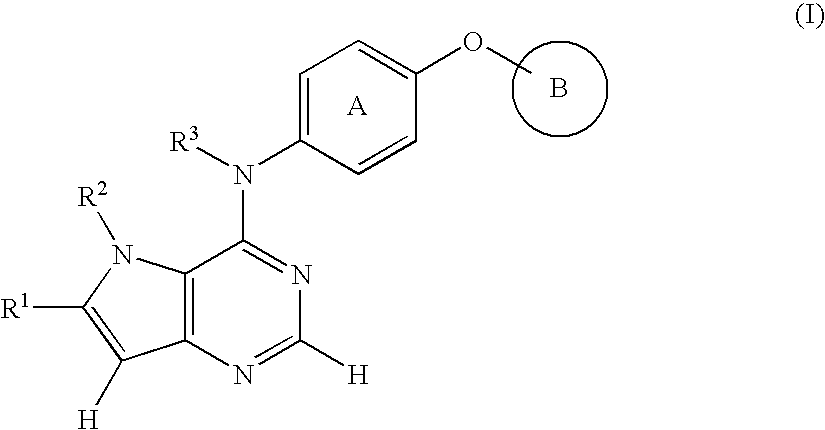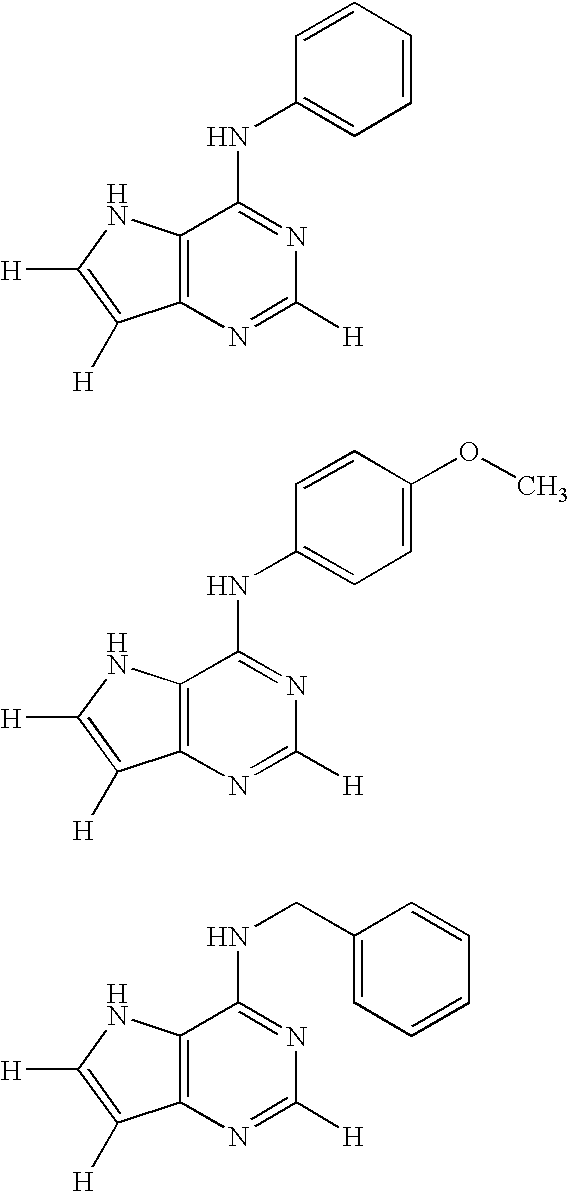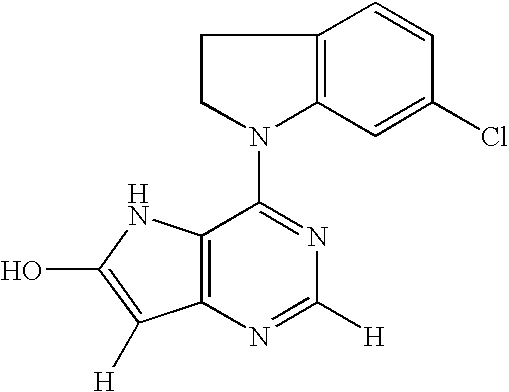Fused heterocyclic compound
a heterocyclic compound and compound technology, applied in heterocyclic compound active ingredients, drug compositions, biocides, etc., can solve the problems of poor prognostic factor, poor receptor expression, high expression and simultaneous expression of each of these receptors, etc., to achieve the effect of high tyrosine kinase inhibitory action, low toxicity, and sufficient pharmaceutical
- Summary
- Abstract
- Description
- Claims
- Application Information
AI Technical Summary
Benefits of technology
Problems solved by technology
Method used
Image
Examples
example 1
[0404]
Production of 2-[4-({3-chloro-4-[(7-methyl-7H-pyrrolo[2,3-d]pyrimidin-4-yl)oxy]phenyl}amino)-5H-pyrrolo[3,2-d]pyrimidin-5-yl]ethanol
(i) Production of 3-chloro-4-[(7-methyl-7H-pyrrolo[2,3-d]pyrimidin-4-yl)oxy]aniline
[0405]4-Chloro-7H-pyrrolo[2,3-d]pyrimidine (1 g) was dissolved in N,N-dimethylformamide (7.2 mL), potassium carbonate (1.35 g) and methyl methanesulfonate (0.55 mL) were added, and the mixture was stirred at room temperature for 2 hr. The mixture was partitioned between ethyl acetate (80 mL) and water (80 mL), and the organic layer was dried over anhydrous magnesium sulfate and concentrated under reduced pressure. The residue was dissolved in N,N-dimethylformamide (10 mL), potassium carbonate (990 mg) and 4-amino-2-chlorophenol (857 mg) were added, and the mixture was stirred at 120° C. for 16 hr. The mixture was partitioned between ethyl acetate (150 mL) and water (100 mL), and the organic layer was dried over anhydrous magnesium sulfate and concentrated under redu...
example 2
[0409]
Production of N-(tert-butyl)-5-(2-chloro-4-{[5-(2-hydroxyethyl)-5H-pyrrolo[3,2-d]pyrimidin-4-yl]amino}phenoxy)pyridine-2-carboxamide
(i) Production of N-(tert-butyl)-5-hydroxypyridine-2-carboxamide
[0410]5-Hydroxypyridine-2-carboxylic acid (1.50 g) was dissolved in a mixed solvent of tetrahydrofuran (7.5 mL) / N,N-dimethylformamide (7.5 mL), tert-butylamine (1.7 mL), 1-hydroxybenzotriazole (2.20 g), triethylamine (4.5 mL) and 1-ethyl-3-(3-dimethylaminopropyl)carbodiimide hydrochloride (3.10 g) were successively added, and the mixture was stirred at room temperature for 24 hr. Water was added to the reaction mixture, and the mixture was extracted with ethyl acetate. The organic layer was washed with saturated brine, dried over anhydrous magnesium sulfate, and concentrated under reduced pressure. The residue was separated and purified by silica gel column chromatography (hexane:ethyl acetate=33:67→0:100→ethyl acetate:methanol=95:5) to give the title compound (1.05 g) as an orange oi...
example 3
[0418]
Production of N-(tert-butyl)-5-(4-{[5-(2-hydroxyethyl)-5H-pyrrolo[3,2-d]pyrimidin-4-yl]amino}-2-methylphenoxy)pyridine-2-carboxamide
(i) Production of N-(tert-butyl)-5-(2-methyl-4-nitrophenoxy)pyridine-2-carboxamide
[0419]The title compound (691 mg) was obtained as a pale-yellow oil by reaction in the same manner as in Example 2 (ii) and using 2-fluoro-5-nitrotoluene (350 mg), N-(tert-butyl)-5-hydroxypyridine-2-carboxamide (501 mg), potassium carbonate (495 mg) and N,N-dimethylformamide (4 mL).
[0420]1H-NMR (CDCl3) δ: 1.50 (9H, s), 2.39 (3H, s), 6.88 (1H, d, J=9.0 Hz), 7.38 (1H, dd, J=2.8 Hz, 8.5 Hz), 7.83 (1H, br s), 8.05 (1H, dd, J=2.8 Hz, 9.0 Hz), 8.17-8.24 (2H, m), 8.27 (1H, d, J=2.8 Hz).
(ii) Production of 5-(4-amino-2-methylphenoxy)-N-(tert-butyl)pyridine-2-carboxamide
[0421]The title compound (588 mg) was obtained as an orange powder by reaction in the same manner as in Example 2 (iii) and using N-(tert-butyl)-5-(2-methyl-4-nitrophenoxy)pyridine-2-carboxamide (689 mg), reduc...
PUM
| Property | Measurement | Unit |
|---|---|---|
| temperature | aaaaa | aaaaa |
| temperature | aaaaa | aaaaa |
| reaction time | aaaaa | aaaaa |
Abstract
Description
Claims
Application Information
 Login to View More
Login to View More - R&D
- Intellectual Property
- Life Sciences
- Materials
- Tech Scout
- Unparalleled Data Quality
- Higher Quality Content
- 60% Fewer Hallucinations
Browse by: Latest US Patents, China's latest patents, Technical Efficacy Thesaurus, Application Domain, Technology Topic, Popular Technical Reports.
© 2025 PatSnap. All rights reserved.Legal|Privacy policy|Modern Slavery Act Transparency Statement|Sitemap|About US| Contact US: help@patsnap.com



